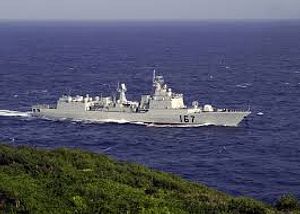Earlier this week, China held a three-ship naval exercise in the Indian Ocean, conducting a series of exercises including combat simulations. According to the Associated Press, the task force then sailed through to the western Pacific by way of the Lombok Strait near Indonesia’s Bali island, approaching the Philippines. Before conducting a five-day exercise in the Indian Ocean, the ships had additionally patrolled the James Shoal, which is currently disputed between China and Malaysia (although Malaysia military officials are reportedly disputing the idea that China patrolled the area in late January).
The task force consisted of the Changbaishan–China’s largest amphibious landing ship–and two destroyers–the Wuhan and Haikou. According to Chinese state broadcaster CCTV, the ships carried out counter-piracy, search and rescue, and damage control drills. The ships eventually left the Indian Ocean to continue their drills in the Western Pacific Ocean. The Changbaishan is one of the more advanced ships in the PLAN’s fleet and is capable of launching helicopters and amphibious landing craft.
China has conducted naval drills in the Indian Ocean in the past but has generally focused on restricting these to its western waters, by the Gulf of Aden. For example, an exercise in August 2013 saw the U.S. and Chinese navies jointly practice counter-piracy operations in the Gulf of Aden which is generally a hot region for pirates based off the Horn of Africa.
These exercises by contrast are potentially far more provocative for India, Australia, and ASEAN states (even though Southeast Asia isn’t bereft of pirates by any means). For India, a Chinese approach in the eastern Indian Ocean raises anxieties about the reach of China’s navy. India regards the eastern Indian Ocean–the space between the Andaman and Nicobar Islands and Sumatra–as its domain. Any Chinese exercises in this area, particularly combat simulations, will not be taken lightly by New Delhi.
Australia is generally content to accept the Indonesian archipelago as a comfortable buffer zone from the busy sea lanes of the South China Sea. By way of this exercise, China demonstrates an operational ability in Australia’s northern waters which could have implications for Australia in the future. Rory Medcalf of the Lowy Institute, an Australian think-tank, notes that “the precise strategic implications of the Chinese navy’s newly-demonstrated ability to operate in Australia’s northern approaches are open to debate.”
For China, the exercises make perfect sense in its bid to field a blue-water navy capable of operating outside China’s proximate waters. Medcalf notes that while these exercises will surely spook some observers in the region, there is “nothing illegal or fundamentally hostile about what the Chinese navy has just demonstrated.”
Indian observers appear to be more concerned by the exercise. One Indian commentator, Srikanth Kondapalli, notes that the exercise sends a signal to India that China “can come closer to the Andaman & Nicobar joint command through Lombok, and not just through Malacca.” He additionally notes that China could be testing the waters in the eastern Indian Ocean, including its ability to operate some distance away from its bases in the region.
The Hindu’s Ananth Krishnan notes that the exercises could also reflect China’s desire to hedge its reliance on the Strait of Malacca–a major waterway for Middle Eastern oil and other imports. 80 percent of China’s fossil fuel imports travel via the strait. Beijing has already invested heavily in Pakistan, Myanmar, and Bangladesh to better connect itself with the Indian Ocean. Generally speaking, China hasn’t seen the less-trafficked straits of Lombok, Sunda, and Makassar to the south as vital to its so-called “Malacca dilemma,” but this could be changing.

































